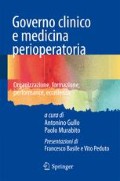Riassunto
Un adeguato monitoraggio del dolore acuto postoperatorio, nei pazienti pediatrici, è di fondamentale importanza, non solo per motivi etici ma soprattutto a causa delle ripercussioni sullo stato di salute attuale e futuro del bambino causate da un’inadeguata gestione del dolore stesso [1].
Access this chapter
Tax calculation will be finalised at checkout
Purchases are for personal use only
Preview
Unable to display preview. Download preview PDF.
Bibliografia
Carr DB (2005) Why children’s pain matters. IASP Pain Updates 13:1–6
Vila H, Smith RA, Augustynaik MJ et al (2005) The efficacy and safety of pain management before and after implementation of hospital-wide pain management standards: is patient safety compromised by treatment based solely on numerical pain ratings? Anesth Analg 101:474–480
Legge 15 marzo 2010, N. 38. Gazzetta Ufficiale 65, 19/03/2010
Verghese ST, Hannallah RS (2010) Acute Pain Management in Children. Journal of Pain Research 3:105–123
Desparment J (2009) Acute Pain Service: clinical assessment and standard of care. In: Astuto M (ed), Basics, anesthesia, intensive care and pain in neonates and in children. Springer-Verlag Italia, Milano, pp 173–184
American Society of Anesthesiologists Task Force on Acute Pain Management (2004) Practice guidelines for acute pain management in the perioperative setting: an updated report by the American Society of Anesthesiologists Task Force on Acute Pain Management. Anesthesiology 100:1573–1581
Kehlet H, Jensen TS, Woolf CJ (2006) Persistent postsurgical pain: risk factors and prevention. Lancet 367:1618–1625
Rose JB, Logan DE (2004) Pediatric pain assessment. In: Litman RS (ed) Pediatric anesthesia. The requisites in anesthesiology. Elsevier Mosby, Philadelphia, pp 191–195
Fitzgerald M, Howard RF (2002) The neurobiologic basis of paediatric pain. In: Schecter NL, Berde CB, Yaster M (eds) Pain in infants, children and adolescents. Lippincott Williams and Wilkins, Baltimore, pp 19–42
Drendel AL, Kelly BT, Ali S (2011) Pain assessment for children: overcoming challenges and optimizing care. Pediatr Emerg Care 27:773–781
Fitzgerald M, Walker S (2003) The role of activity in developing pain pathways. In: Dostrovsky JO, Carr DB, Koltzenburg M (eds) Proceedings of the 10th World Congress on Pain. Progress in pain research and management. IASP Press, Seattle, pp 185–196
Fitzgerald M (2005) The development of nociceptive circuits. Nat Rev Neurosci 6:507–520
Taddio A, Katz J, Ilersich AL et al (1997) Effect of neonatal circumcision on pain response during subsequent routine vaccination. Lancet 349:599–603
Howard RF (2003) Current status of pain management in children. JAMA 290:2464–2469
Hullett B, Chambers N, Preuss J (2009) Monitoring electrical skin conductance: a tool for the assessment of postoperative pain in children? Anesthesiology 111:513–517
Ghai B, Makkar JK, Wig J (2008) Postoperative pain assessment in preverbal children and children with cognitive impairment. Paediatr Anaesth 2008 18:462–477
Sweet SA, McGrath PJ (1998) Physiological measures of pain. In: Finley GA, McGrath PJ (eds) Measurement of Pain in Infants and Children. Progress in Pain Research and Management, Vol. 10. IASP Press, Seattle, pp 59–82
McGrath PJ (1998) Behavioral measures of pain. In: Finley GA, McGrath PJ (eds) Measurement of Pain in Infants and Children. Progress in Pain Research and Management, Vol. 10. IASP Press, Seattle, pp 83–102
Franck LS, Greenberg CS, Stevens B (2000) Pain assessment in infants and children. Pediatr Clin North Am 47:487–512
Chen LL, Ballantyne JC (2006) Postoperative pain in children. In: Ballantyne JC (ed) The Massachusetts General Hospital handbook of pain management. 3rd edn. Lippincott Williams & Wilkins, Baltimore, pp 302–316
Wallin BG (1981) Sympathetic nerve activity underlying electrodermal and cardiovascular reaction in man. Psychophysiology 18:470–476
Glandman G, Chiswick ML (1990) Skin conductance and arousal in the newborn. Arch Dis Child 65:1063–1066
Gutrecht JA (1994) Sympatheric skin response (review). J Clin Neurophyisiol 11:519–524
Tranel D, Damasio H (1994) Neuroanatomical correlates of electrodermal skin conductance responses. Psychophysiology 31:427–438
Storm H, Fremming A, Odegaard S et al (2000) The development of a software program for analyzing spontaneous and externally elicited skin conductance changes in infants and adults. Clinical Neurophysiology 111:1889–1898
Edelberg R (1967) Electrical properties of the skin. In: Brown CC (ed) Methods in psychophysiology. Williams & Wilkins, Baltimore, pp 1–59
Christie MJ (1981) Electrodermal activity in the 1980’s: a review. J R Soc Med 74:616–622
Gjerstad AC, Storm H, Wallin G (2006) Evaluation of the skin conductance method by using microneurographi. [abstract]. ISAP, Chicago
Storm H (2008) Changes in skin conductance as a tool to monitor nociceptive stimulation and pain. Curr Opin Anesthesiol 21:796–804
Storm H, Myre K, Rostrup M et al (2002) Skin conductance correlates with perioperative stress. Acta Anaesthesiol Scand 46:887–895
http://www.med-storm.com/pdf/MA001-25_Manual.pdf
Bini G, Hagbarth KE, Hynninen P, Wallin BG (1980) Thermoregulatory and rhythm generating mechanisms governing the sudomotor and vasoconstrictor outflow in human cutaneous nerves. J Physiol 306:537–552
Ledowski T, Ang B, Schmarbeck T, Rhodes J (2009) Monitoring of sympathetic tone to assess postoperative pain: skin conductance vs surgical stress index. Anaesthesia 64:727–731
Ledowski T, Bromilow J, Paech MJ et al (2006) Monitoring of skin conductance to assess postoperative pain intensity. British Journal of Anaesthesia 97:862–865
Ledowski T, Bromilow J, Wu J et al (2007) The assessment of postoperative pain by monitoring skin conductance: results of a prospective study. Anaesthesia 62:989–993
Choo EK, Magruder W, Montgomery C (2010) Skin conductance fluctuations correlate poorly with postoperative self-report pain measures in school-aged children. Anesthesiology 113:175–182
Ledowski T, Albus S, Stein J, Macdonald B (2011) Skin conductance for monitoring of acute pain in adult postoperative patients: influence of electrode surface area and sampling time. J Clin Monit 25:371–376
Ledowski T, Stein J, Albus S, MacDonald B (2011) The influence of age and sex on the relationship between heart rate variability, haemodynamic variables and subjective measures of acute post-operative pain. Eur J Anaesthesiol 28:433–437
Author information
Authors and Affiliations
Editor information
Editors and Affiliations
Rights and permissions
Copyright information
© 2012 Springer-Verlag Italia
About this chapter
Cite this chapter
Astuto, M., Arena, G., Sardo, M., Murabito, P., Storm, A. (2012). Monitoraggio del dolore postoperatorio nei pazienti pediatrici. In: Gullo, A., Murabito, P. (eds) Governo clinico e medicina perioperatoria. Springer, Milano. https://doi.org/10.1007/978-88-470-2793-0_21
Download citation
DOI: https://doi.org/10.1007/978-88-470-2793-0_21
Publisher Name: Springer, Milano
Print ISBN: 978-88-470-2792-3
Online ISBN: 978-88-470-2793-0
eBook Packages: MedicineMedicine (R0)

